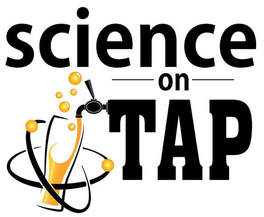
Join Cool Science for Science on Tap every 2nd Monday of the month [except this month- see below] at Jack Quinn’s Irish Pub & Restaurant in downtown Colorado Springs. Presenters begin at 6:30 pm and typically speak for 60-90 minutes including Q&A, with food and drink available beginning at 6:00 pm. A wide variety of fascinating topics are presented by local scientists for informal discussion, and the relaxed atmosphere encourages anyone and everyone to come explore the latest ideas in science and technology. From practical to theoretical, the presentations and group interactions provide a fun and interesting way to gain an understanding of the world around us.
Join Cool Science for Science on Tap every 2nd Monday of the month [except this month- see below] at Jack Quinn’s Irish Pub & Restaurant in downtown Colorado Springs. Presenters begin at 6:30 pm and typically speak for 60-90 minutes including Q&A, with food and drink available beginning at 6:00 pm. A wide variety of fascinating topics are presented by local scientists for informal discussion, and the relaxed atmosphere encourages anyone and everyone to come explore the latest ideas in science and technology. From practical to theoretical, the presentations and group interactions provide a fun and interesting way to gain an understanding of the world around us.
Next up: Monday, July 10, 2023 at 6:30 pm
Solar Flares and Super Constellations: Are Satellites in Space Safe?
1Lt Jonathan Novak, USSF Engineer, MIT
Summary: Solar weather operates on an 11-year cycle, swinging from solar minimum to solar maximum and back. During solar maximum, solar flares and coronal mass ejections occur most frequently. The sun is currently approaching a solar maximum, meaning that satellite systems are at the highest risk of experiencing adverse solar weather effects. Traditional satellite systems are designed to be exceptionally resilient against these solar weather effects but the new paradigm of proliferated satellite systems, such as the multi-billion dollar Starlink constellation, are less robustly designed than traditional systems. Thus, the questions are posed: 1) Could an extreme solar weather event cause immediate, catastrophic failure for an entire proliferated constellation of hundreds or thousands of satellites? 2) What is the probability that an extreme event occurs? And 3) What, if anything, can we do? Join me, as I distill hundreds of hours of modeling and simulation, hundreds of pages of research, and 2 years of tireless work into 60-90 minutes of nail-biting grandeur and pure, scientific adrenaline.
1Lt Jonathan Novak is currently a mission assurance engineer at Schriever, SFB. His research interests are in space systems engineering, space strategy, and interplanetary exploration. He graduated from the United States Air Force Academy in 2020 with a degree in systems engineering and from MIT in 2022 with an M.S. in Technology and Policy. His work on the resilience of proliferated satellite constellations against solar weather radiation effects won the 2022 MIT Technology and Policy program’s “Best Thesis” award and is published in international, peer review journals.









